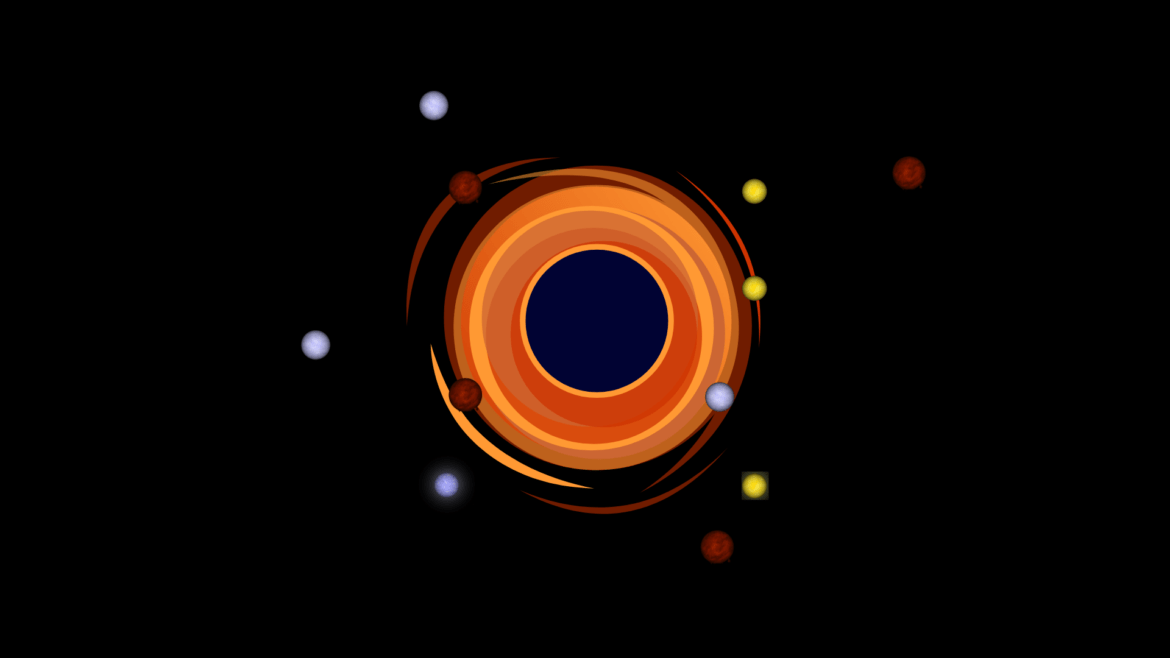Black holes are entirely invisible. They are so dense that their gravitational pull absorbs all light and won’t let them escape the singularity. How do astronomers spot black holes despite these circumstances? Let’s find out in this article.
Harnessing the Gravitational Pull
The most magnificent property of black holes is their gravity and unimaginable escape velocity, which exceeds the speed of light, so why don’t we use them for observation? Objects, like stars, will fall toward a black hole or orbit it quickly when it gets close to one, and might even be swallowed by its strong gravitational pull.
That’s exactly how we observe the existence of black holes. When we look at a patch of stars, if we can see a pattern that points out an invisible object that seems to attract, be orbited by, or even swallow stars, we can determine that this object is a black hole.
However, astronomers might not be able to directly spot erratic behavior of stars as they might simply be too small for even modern telescopes to detect. However, when a black hole swallows some massive object, it leaves an accretion disk behind that it can slowly absorb. Due to the enormous friction the matter in the disk is facing, the material heats up dramatically, emitting light of very short wavelengths, enabling black holes to be discovered. Keep in mind that you might have to look for certain signatures as there are many sources of such radiation.
Determining the Properties
After finding out about a potential black hole, it’s time to find its properties. For instance, astronomers should look at how the black hole is swallowing the star by direct imaging or imaging of shorter wavelengths, and the stronger the reaction between the black hole and the star, the more massive the black hole. Interestingly, the mass of a black hole directly determines its diameter since the size of the black hole is how large the event horizon is. If you don’t know what an event horizon is, it’s the point where it becomes impossible to escape from the black hole. In the center of every black hole is an infinitely small singularity that holds all its mass.

Image created using Canva
How about the type of black hole? This can be determined from its mass as well. A stellar-mass black hole is one with a few times to a few hundred times the mass of our Sun, a supermassive black hole contains at least one million solar masses of matter, and an intermediate black hole is any black hole in between.
Once you’ve determined the mass of the black hole, it’s also good to see if it is spinning because it might affect the mechanics inside of it. This can be done by looking at how far the inner edge of the accretion disk is from the black hole. The closer it is, the more angular momentum the black hole has attained.
How about the distance of the black hole? To obtain that, you should search for the distance to nearby objects or structures. Find out about some ways here to check them out.
Conclusion
In this short article, we found out how astronomers spot invisible black holes and determine some of their characteristics without direct observations. We have already directly seen the accretion disks of some supermassive black holes, including that in our galaxy. Also, galactic centers are great places to spot these mysterious structures as almost all sufficiently massive galaxies contain black holes at their center. If you want to get more related information, please visit the webpages in the references below.
References and Credits
- (n.d.). Black Holes. Retrieved May 17, 2022, from https://science.nasa.gov/astrophysics/focus-areas/black-holes
- Tillman, N. T., et al. (2022, May 6). Black holes: Everything you need to know. Retrieved May 17, 2022, from https://www.space.com/15421-black-holes-facts-formation-discovery-sdcmp.html
- (2020, September 8). What Are Black Holes? Retrieved May 17, 2022, from https://www.nasa.gov/vision/universe/starsgalaxies/black_hole_description.html
- (2013, February 27). How to Measure the Spin of a Black Hole. Retrieved May 17, 2022, from https://www.nasa.gov/mission_pages/nustar/multimedia/pia16696.html

